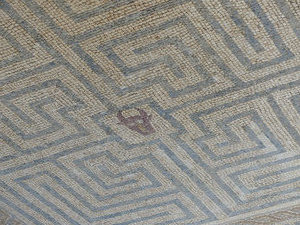Advertisement
Published: September 14th 2013

 Coninbriga
Coninbriga
The maze and the minotaur We left the site at Porto fairly early in the morning with the intention of travelling 2 hours to Conimbriga the largest and most extensively excavated Roman site in Portugal which was on the Roman road between Lisbon (Olisipo) and Braga. Originally there was a Celtic site here. On the way we saw trees burnt the evidence of large scale fires this summer. The roads were empty as we sailed through with our Via Verdi box. Eucalyptus trees and olive groves replaced the wheat fields we had encountered so far.
The site was quite difficult to find. Our sat nav directed us through the narrow streets of the town. Just wide enough for Suzy until we came to the roadworks and the way through closed. The local policeman was directing traffic around the town and he directed Suzy up an even more narrow road.
Eventually after much driving round going nowhere we arrived at the site of the ruins. A good large car park was empty and the place itself quiet as the grave. Entry fee 2 euros for reduced over 65’s and 4 euros general rate. It seems the norm that on Sundays most museums and castles in

 Coninbriga
Coninbriga
One of the mosaic floors Portugal are free to enter between 9 and 2 pm. Great but today was Thursday.
We were a little underwhelmed with the site having read the blog about it. Not a latrine in sight for Sion to share with his best friend Woolly Mammoth. It seemed that the emperor Augustus had turned Coningbriga from a small provincial outpost to a substantial town with baths, a forum and an acqueduct in 25BC. The remaining buildings on site where built between the 2
nd and 3
rd centuries AD.
There is a section of roman road along the way alongside which are clustered houses of various sizes, shops with ornate mosaic floors.
Official excavations began in 1912 and there are still substantial amounts of buildings still underground awaiting further excavation. Only 13 hectares of the site have been dug which means there is still a lot to go at. Whether it will be excavated is debateable despite the site having EU money thrown at it.
There was a small museum with a rather nice collection of Roman coins, cooking vessels, jewellery, busts and statues. The café was closed which was a shame. The journey from the site was a little

 Coninbriga
Coninbriga
Under cover Mosaic floors easier on the main roads which were relatively empty.
Our first thoughts on Portugal. The country is more interesting than Spain, the people friendlier or more keen to help, most speak English to a greater or lesser degree and are happy to use it. The food is good, the roads empty and the standard of driving excellent compared to other southern European countries. None of the car horn honking, hand waving and erratic driving of the Italians.
Advertisement
Tot: 0.078s; Tpl: 0.013s; cc: 13; qc: 28; dbt: 0.0375s; 1; m:domysql w:travelblog (10.17.0.13); sld: 1;
; mem: 1.1mb

 Coninbriga
Coninbriga
 Coninbriga
Coninbriga 
 Coninbriga
Coninbriga 








